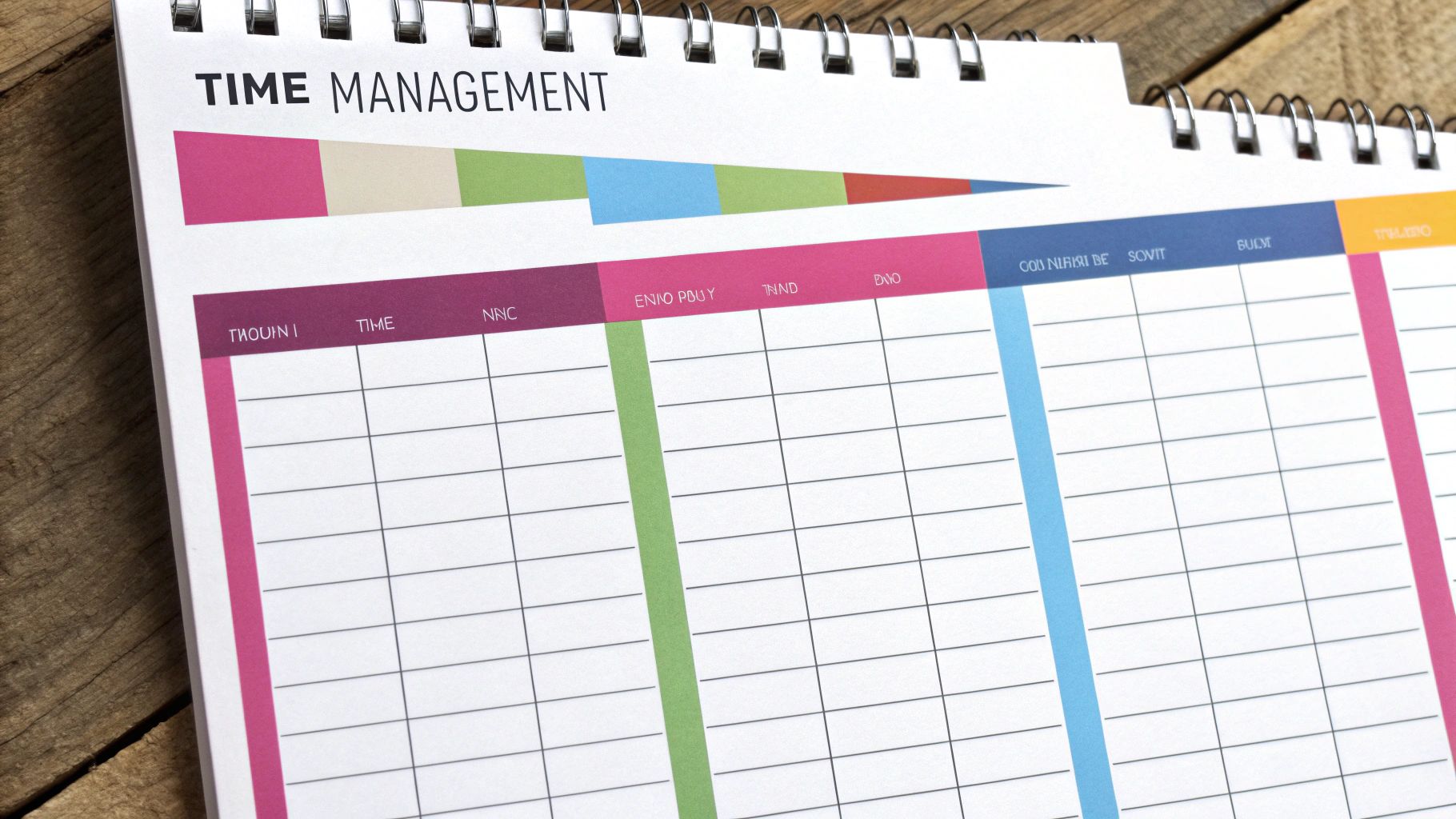
How to Study Effectively: The Science-Backed Path to Academic Excellence
Understanding Your Brain's Natural Learning Rhythms

Studying effectively starts with understanding how your brain naturally processes and retains information. Just as athletes train according to their physical capabilities, successful learning requires working in sync with your brain's natural patterns. By paying attention to when you focus best, how long you can concentrate, and which learning methods click with you, you can make studying much more productive.
Identifying Your Peak Learning Hours
Your brain's ability to absorb information isn't constant throughout the day. Some people think most clearly in the morning quiet, while others do their best work late at night. This variation stems from your circadian rhythm – your internal body clock that regulates alertness and focus. To find your optimal study time, try focused learning sessions at different hours. For instance, study for an hour right after breakfast, then try another session in the late afternoon. Make note of when you feel most alert and retain information best. Once you identify these peak periods, schedule your most challenging work during those times.
Working With Your Natural Attention Span
Research shows that our brains naturally cycle between periods of focus and mental rest. This pattern, called the ultradian rhythm, typically runs in 90-120 minute intervals. Fighting against these natural cycles by forcing yourself to focus for too long often backfires, leading to mental exhaustion and poor retention. Instead, work with these natural rhythms by studying in 45-60 minute blocks followed by 10-15 minute breaks. During breaks, step away from your desk, move around, or do something relaxing. This approach helps you maintain strong focus when it matters most.
Leveraging Your Unique Learning Preferences
Everyone absorbs information differently. Visual learners grasp concepts best through diagrams, charts and images. Auditory learners benefit most from listening to explanations and discussing ideas. Kinesthetic learners understand things by doing hands-on activities. Finding your primary learning style can make a big difference in how well you understand and remember material. Test different methods – try drawing concept maps, recording yourself explaining topics, or creating physical models to represent ideas. Pay attention to which approaches help information stick best, then make those methods a regular part of your study routine.
Understanding your brain's natural learning patterns isn't just about efficiency – it's about making learning more sustainable and enjoyable. When you recognize your peak performance times, respect your natural attention cycles, and use learning methods that work for you, studying becomes less of a chore and more of a skill you can develop. This foundation sets you up to better use specific study techniques like active recall and spaced repetition, which we'll explore next.
Mastering Time Without Losing Your Life
Learning to study effectively isn't about cramming more hours into your day. Building on our earlier discussion of natural learning rhythms, let's explore how to create a study system that works with your brain – not against it. By understanding and working with your own natural patterns and habits, you can make the most of your study time while maintaining balance in other areas of your life.
Building Your Personalized Study Schedule
Success starts with understanding when your mind is sharpest. Instead of forcing yourself to study when you're mentally foggy, match your most challenging work to your peak energy hours. Morning people may want to tackle complex subjects like organic chemistry right after breakfast, while night owls could save their most demanding work for evening hours when they're naturally more alert. This simple alignment can dramatically improve both focus and retention.
The Power of Focused Study Blocks
Your natural attention cycles provide an excellent framework for structuring study sessions. Work in focused 45-60 minute blocks on a single topic, then take a real 10-15 minute break. This approach works with your brain's natural rhythms, helping you stay fresh and engaged. During breaks, step away completely – go for a walk, listen to music, or do some quick exercises. The mental reset prevents burnout and helps you return ready to focus again.
Taming Procrastination and Staying on Track
We all face procrastination at times. One effective way to overcome it is breaking large tasks into smaller, concrete steps. Rather than thinking "I need to write a 10-page paper," start with "Today I'll write just the introduction." This makes the work feel more manageable and gives you the momentum to begin. Using a timer for your study blocks can also help by creating gentle urgency and structure.
Creating a Flexible Framework
Life rarely goes exactly according to plan. Build flexibility into your schedule by having backup options for when things come up. If you miss a planned study session, know when you can make it up later in the week. This adaptability lets you stay on track with your learning goals while still having room for other priorities and commitments. The key is finding sustainable balance.
Troubleshooting Your Time Management
Even with solid plans, challenges can arise. When you consistently struggle to stick to your schedule, take time to identify the root causes. Are you trying to do too much? Do you need longer breaks? Are you getting enough sleep? Honest assessment of what's working and what isn't will help you refine your approach. Remember, the goal is finding a study routine that works for your unique needs and circumstances.
Leveraging Active Recall for Deep Learning

After mastering time management and understanding your peak learning periods, active recall becomes essential for effective studying. Unlike passively rereading notes, active recall requires you to pull information directly from your memory, which strengthens how well you remember and understand concepts. Think about learning a new language – simply reading a phrasebook helps you recognize words, but you only truly learn by practicing speaking. Active recall works the same way by making your brain retrieve and apply what you've studied.
Why Active Recall Is So Effective
When you use active recall, your brain has to work hard to reconstruct information rather than just recognizing it. This mental effort builds stronger memory connections, similar to how exercising builds muscle strength. The more you practice recalling information, the better you get at remembering it. This is very different from passive methods like rereading, which might make material feel familiar without helping you truly understand it.
Practical Applications of Active Recall
You can add active recall to your study routine in several straightforward ways. One effective method is creating your own practice questions about the material you're learning. These questions should target key concepts and push you to apply your knowledge. Flashcards are another excellent tool – write a question on one side and the answer on the other. Regular practice with flashcards forces your brain to retrieve information, helping cement it in your memory.
Combining Active Recall with Spaced Repetition
Active recall becomes even more powerful when paired with spaced repetition. This technique involves reviewing material at gradually increasing intervals, taking advantage of how memories naturally fade over time. By spacing out when you review topics – for example, studying them one day later, then three days later, then a week later – you challenge your brain to recall information right as it starts to fade. This timing helps lock the information into your long-term memory.
Designing Effective Study Materials for Active Recall
To get the most from active recall, carefully structure your study materials. Break complex topics into smaller, manageable sections that you can practice individually. Create visual summaries or mind maps to organize information and show how ideas connect. Try explaining concepts to others – teaching requires you to retrieve and organize information clearly, which strengthens your own understanding. Using these approaches turns studying from passive reading into an engaging process of building lasting knowledge.
Creating Your Ideal Study Sanctuary
Your study environment directly impacts how well you learn and retain information. A well-designed study space helps you focus deeply on your work, while a cluttered or distracting environment can derail your concentration. By thoughtfully setting up your study area, you can create conditions that support effective learning.
The Psychology of Effective Study Environments
Our brains constantly process information from our surroundings. When you try to study in a noisy coffee shop or uncomfortable chair, your brain has to work overtime to filter out distractions. This splits your mental energy between managing disruptions and actually learning the material. For instance, background conversations, movement, and other stimuli compete for your attention, making it harder to concentrate on your studies. In contrast, a quiet, organized space with proper lighting allows your brain to focus its resources on absorbing and processing new information.
Essential Elements of a Productive Study Space
You don't need an elaborate setup to create an effective study environment. Simple changes can make a big difference in your ability to focus. Start by removing common distractions – silence your phone notifications, use Noise-Canceling Headphones if needed, and let others know when you need uninterrupted time. Good lighting is vital too – natural light works best, but a quality desk lamp can prevent eye strain when natural light isn't available.
Ergonomics and Physical Comfort
Your physical comfort directly affects your ability to concentrate. An uncomfortable chair leads to constant shifting and fidgeting that breaks your focus. Consider investing in a supportive chair that helps maintain good posture. Position your desk and computer screen at the right height to avoid neck and back strain. These ergonomic adjustments help you stay physically comfortable so you can maintain focus during long study sessions.
Personalizing Your Study Zone
While certain elements of an effective study space are universal, personal preferences matter too. Some students need complete silence to concentrate, while others work better with background music or ambient noise. Try different approaches – like instrumental music or nature sounds – to find what helps you focus best. The key is creating a space that feels comfortable and motivating to you personally. When you enjoy spending time in your study area, you're more likely to use it consistently and productively. Making your study environment uniquely yours helps build positive associations with learning and makes studying feel more approachable.
Using Technology Without Getting Distracted

While technology provides excellent tools for learning, it can easily become a source of distraction. Being successful with digital tools requires a balanced and intentional approach – knowing how to use them to support your learning goals while avoiding common pitfalls. This section will help you create focused study habits that make the most of technology's benefits while keeping distractions in check.
Selecting Tools That Actually Help You Study
Not every app or platform will benefit your learning process. Some tools excel at helping you absorb and process information, while others mainly serve to entertain. The key is identifying which ones genuinely support your study goals. For instance, Evernote and OneNote help organize notes into searchable formats that are more practical than paper notebooks. Anki uses proven memory techniques to help you retain information effectively. Remember though – even helpful tools can derail your focus if not used purposefully.
Keeping Digital Distractions Under Control
Our devices often pull our attention away from studying through constant notifications, alerts, and endless content streams. Taking back control requires setting clear boundaries around technology use. This means turning off notifications during study sessions, using website blockers for distracting sites, and scheduling specific times to check email and social media rather than letting them interrupt your work. By being proactive about managing these interruptions, you can maintain better focus on your studies.
Setting Up Your Digital Space for Success
Your digital workspace impacts your productivity just like your physical study environment. A cluttered computer can be just as distracting as a messy desk. Create an organized system by sorting files into clear folders, using cloud storage for easy access, and finding the right tools to track tasks and deadlines. For example, Trello or Asana can help break big projects into smaller, manageable steps with their own deadlines. This structured approach makes challenging assignments feel more achievable.
Using Technology Thoughtfully in Your Study Plan
Technology works best when it supports rather than drives your study habits. The key is choosing digital tools that match your learning style and incorporating them strategically into your overall approach. You might use online resources alongside textbooks, join virtual study groups, or schedule online tutoring sessions. This balanced method lets you benefit from technology while maintaining effective study routines. By making conscious choices about when and how to use digital tools, they remain helpful resources rather than becoming obstacles to learning.
Building Study Habits That Actually Last

Creating lasting study habits involves more than just forcing yourself to sit down with your books. Like training for a marathon, where you gradually build up your stamina rather than attempting the full distance on day one, effective studying requires a systematic approach. By focusing on small, consistent actions rather than relying on sporadic bursts of motivation, you can develop study routines that become a natural part of your daily life.
Understanding the Psychology of Habit Formation
At its core, habit formation follows a simple pattern: a cue triggers a routine, which leads to a reward. For studying, this might mean setting aside a specific time each day (the cue), completing your study session (the routine), and feeling accomplished or seeing improved test scores (the reward). When you understand this pattern, you can deliberately structure your study habits to make them stick. For instance, you might choose to study right after dinner each night, making your evening meal the natural cue to begin.
Strategies for Building Lasting Study Habits
The key to creating study habits that last is starting small. Rather than trying to completely change your routine overnight, begin with just 30 minutes of focused study time each day. Once this becomes comfortable, you can gradually extend the duration. This gentle approach makes the new habit feel less daunting and increases your chances of success.
Try connecting your study sessions to activities you already do regularly. For example, if you commute by bus, use that time for reviewing notes, or study right after your morning coffee. When you link studying to existing parts of your day, it becomes more automatic and requires less conscious effort to maintain the habit.
Maintaining Motivation and Overcoming Setbacks
Everyone experiences ups and downs in motivation. During tough periods, reconnect with your deeper reasons for studying. If you're working toward a medical degree, picture yourself helping patients and making meaningful contributions to healthcare. This mental connection to your bigger goals can help restore your drive when motivation dips.
Missing study sessions or getting disappointing grades is normal and doesn't mean failure. Instead of getting discouraged, treat these moments as chances to learn and adjust your approach. Maybe you need to find a quieter study spot, try different study methods, or get help from classmates or tutors. Remember that steady progress matters more than perfection.
Tracking Progress and Staying Accountable
Keep track of your study efforts using a simple system like a planner or calendar. Seeing your progress visually helps maintain momentum and shows how far you've come. You can mark completed study sessions, record quiz scores, and note areas where you're improving.
Finding someone to study with adds an extra layer of commitment. Whether it's a study partner or group, sharing your goals with others makes you more likely to follow through. Plus, studying together can make the process more engaging and fun through discussion and mutual support.
Boost your study sessions and transform your PDFs into engaging videos with Notescast! Turn tedious reading into dynamic learning experiences and unlock your full academic potential. Visit Notescast today and discover a smarter way to study.
